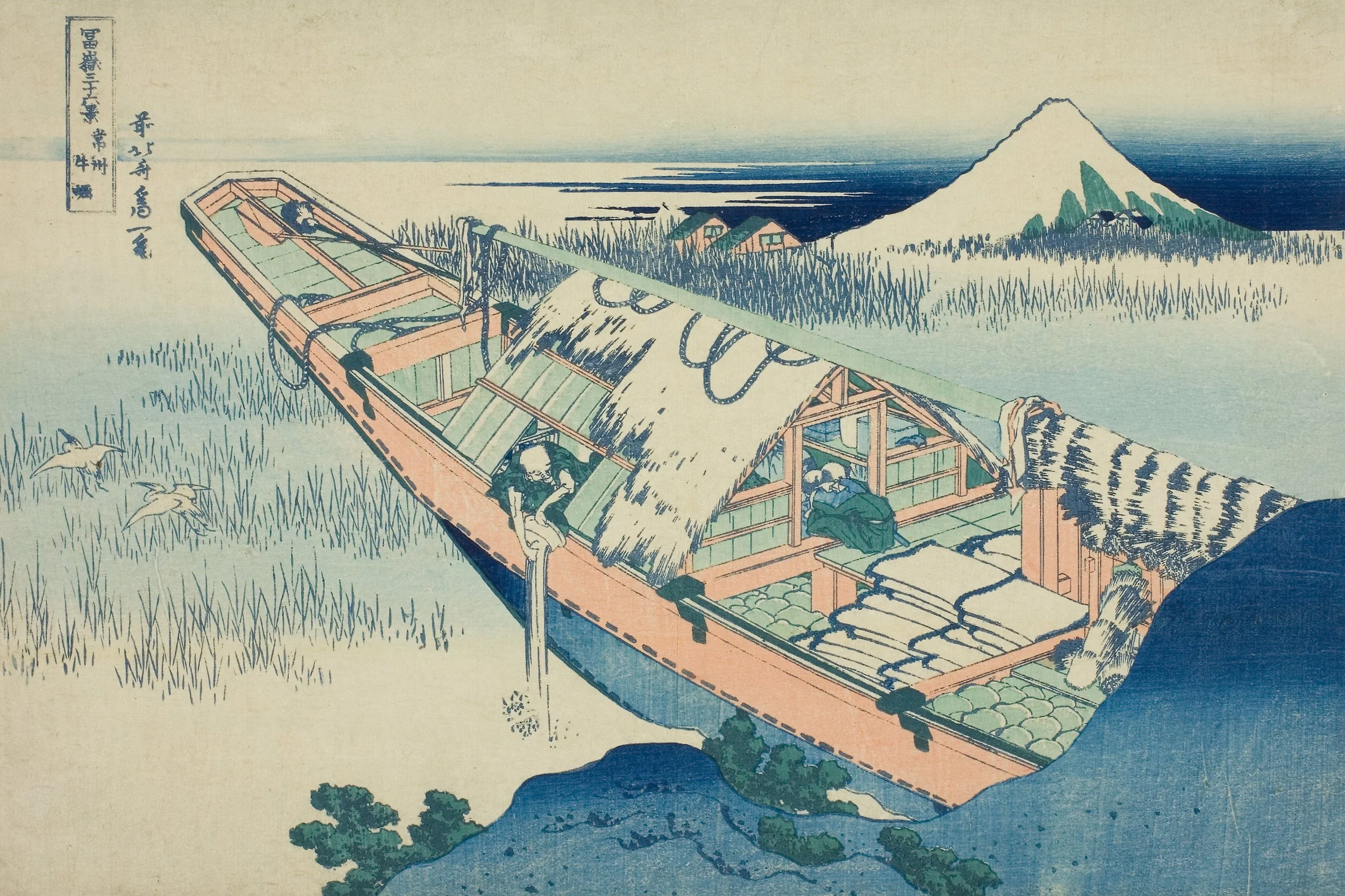13.Ushibori in Hitachi Province 常州牛堀
Ushibori, Jōshū (Present-day Ushibori, Itako City, Ibaraki Prefecture)
A waterside district on Lake Kasumigaura.
Depicted here is an upper-style yakatabune—a type of covered transport boat
also used for commercial purposes.
A closer look reveals the cargo: bundles of mushiro (straw mats), goza, or raw igusa (rush).
Sandbag-like sacks line the bottom of the boat,
perhaps filled with igusa, ash, rapeseed, or other powdered or granular goods.
One of the crew pours rice-washing water into the reeds.
Ushibori was a vital logistics hub in northern Kantō,
with a sea journey of three to four days to Edo.
Given the setting—amid reeds, without a flat loading area—
this is unlikely to be a loading site.
More plausibly, the boat is en route from further north,
possibly from Namegata, a known igusa source,
a day’s sail from Ushibori.
Most likely, a northbound merchant vessel
has anchored overnight at Ushibori,
and as morning breaks, the crew prepares rice before departure.
It is a quiet moment at the start of the day—
a stillness carried on the scent of the sea breeze.
What Hokusai depicted
was not action, but time.
Few artists can convey time
within the stillness of an image.
Yet here, through the simple act of rinsing rice,
we feel the entire moment unfold.
A haiku in visual form.
Herein lies Hokusai’s discerning eye for beauty.
07
14.Kajikazawa in Kai Province 甲州石班澤
Kajikazawa in Kai Province
(Kōshū Kajikazawa — Present-day Kajikazawa, Minamikoma District, Yamanashi Prefecture)
An overwhelming composition.
That alone could suffice.
It is that masterful.
But why is it so exceptional?
Mount Fuji appears to the southeast,
its morning glow conveyed through delicate overprinting in orange—
the time is dawn.
In Hokusai’s compositions, there is no waste.
The main subject is rendered in detail.
Secondary elements are pared down.
Kajikazawa is a textbook example of this.
The turbulent rapids of the Fuji River—
the spray captured with precision.
The jutting rocks and the posture of the fisherman
convey a sense of tension.
Between Mount Fuji and the fisherman
lies a riverbend drawn in smooth curves,
punctuated by areas of open white space.
Foreground vs. background.
Compression vs. diffusion.
By radically simplifying the secondary elements,
the primary subject stands out all the more.
And yet, despite the extremes of contrast,
the composition feels whole.
The flowing lines of the river, drawn with just a few strokes,
seamlessly bridge foreground and background.
Mount Fuji, placed within the simplified background,
approaches the level of a symbol—
captured with only a handful of lines,
yet unmistakable.
Every element in this work has a reason to exist.
A clear hierarchy between protagonist and supporting roles.
A composition that binds them together—
without rupture, without imbalance.
This is achieved through the slightest of curves.
An overwhelming composition.
That alone could suffice.
Herein lies Hokusai’s discerning eye for beauty.

